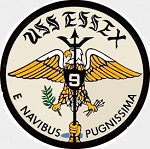Hobby Master HA1222 USN Grumman TBF-1C Avenger Torpedo-Bomber - "White 93", VT-15 "Valions", USS Essex (CV 9), November 1944 (1:72 Scale)
"CAVU (Ceiling and Visibility Unlimited)"
- Term used by naval aviators to describe perfect flight conditions when operating from an aircraft carrier
 The Grumman TBF Avenger (designated TBM for aircraft manufactured by General Motors) was an American torpedo bomber, developed initially for the United States Navy and Marine Corps and used by a large number of air forces around the world. It entered service in 1942, and began major use during the Battle of Midway.
The Grumman TBF Avenger (designated TBM for aircraft manufactured by General Motors) was an American torpedo bomber, developed initially for the United States Navy and Marine Corps and used by a large number of air forces around the world. It entered service in 1942, and began major use during the Battle of Midway.
The Avenger had a large bomb bay, allowing for one Bliss-Leavitt Mark 13 torpedo, a single 2000 lb (900 kg) bomb, or up to four 500 lb (230 kg) bombs. Torpedoes were generally abandoned after Midway and were not carried again regularly until after June of 1944, when improvements mandated their use again. By that time, it was rare for American aircraft to encounter enemy shipping at sea and the Avenger was primarily employed as a ground support weapon. The plane had overall ruggedness and stability, and pilots say it flew like a truck, for better or worse. With a 30,000 foot (10,000 m) ceiling and a fully-loaded range of 1,000 miles (1,600 km), it was better than any previous American torpedo plane, and better than its chief opponent, the then obsolete Japanese Nakajima B5N "Kate".
Pictured here is a 1:72 scale replica of a TBF-1C Avenger torpedo-bomber known as "White 93", which was attached to VT-15 "Valions", then embarked upon the USS Essex (CV 9), during November 1944.
Sold Out!
Dimensions:
Wingspan: 10-inches
Length: 8-inches
Release Date: September 2019
 Historical Account: "Last Gasp" - The Battle of Leyte Gulf is considered to have been the largest naval battle of World War II and, by some criteria, possibly the largest naval battle in history, with over 200,000 naval personnel involved. It was fought in waters near the Philippine islands of Leyte, Samar, and Luzon, from October 23rd-26th, 1944, between combined American and Australian forces and the Imperial Japanese Navy (IJN), as part of the invasion of Leyte, which aimed to isolate Japan from the countries it had occupied in Southeast Asia which were a vital source of industrial and oil supplies.
Historical Account: "Last Gasp" - The Battle of Leyte Gulf is considered to have been the largest naval battle of World War II and, by some criteria, possibly the largest naval battle in history, with over 200,000 naval personnel involved. It was fought in waters near the Philippine islands of Leyte, Samar, and Luzon, from October 23rd-26th, 1944, between combined American and Australian forces and the Imperial Japanese Navy (IJN), as part of the invasion of Leyte, which aimed to isolate Japan from the countries it had occupied in Southeast Asia which were a vital source of industrial and oil supplies.
By the time of the battle, Japan had fewer capital ships (aircraft carriers and battleships) left than the Allied forces had total aircraft carriers, underscoring the disparity in force strength at this point in the war. Regardless, the (IJN) mobilized nearly all of its remaining major naval vessels in an attempt to defeat the Allied invasion, but was repulsed by the U.S. Navy's Third and Seventh fleets.
The battle consisted of four main separate engagements: the Battle of the Sibuyan Sea, the Battle of Surigao Strait, the Battle of Cape Engano and the Battle off Samar, as well as lesser actions.
This was the first battle in which Japanese aircraft carried out organized kamikaze attacks, and the last naval battle between battleships in history. The IJN suffered heavy losses and never sailed in comparable force thereafter, stranded for lack of fuel in their bases for the rest of the war, and were unable to affect the successful Allied invasion of Leyte.


